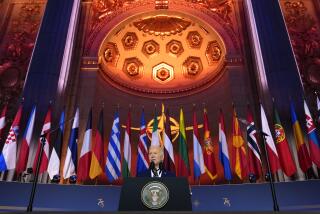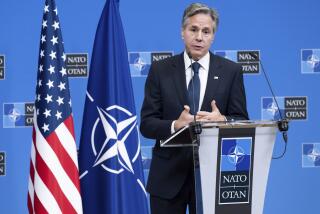A Good Year for the Atlantic Alliance
- Share via
BRUSSELS — My compatriots--and I suspect that they are not alone--are rather fond of looking back to the good old days, when Punch was funnier, English summers more summery, the younger generation somehow less maddening and the Atlantic Alliance stronger and more stable. As it happens, people starting talking about crises in the alliance even before the good old days had had time to grow old. But the obituaries were premature, and they still are. We have, in fact, had rather a good year, and we have every reason to look to the future with confidence.
We have had a good year first of all on the military side. At one end of the spectrum, the deployment of cruise and Pershing-2 missiles in Europe is proceeding on schedule, despite an unrelenting Soviet campaign to blow us off course. At the other, we are getting to grips with the sort of problems that wouldn’t hit the headlines until it was too A Good Year for the Atlantic Alliance
late: weaknesses in infrastructure, shortages of ammunition and the like. And to link the two ends, we have established a decision-making framework that combines the identification of key deficiencies with the political commitment to do something about them.
I don’t expect miracles, but I do expect a steady pattern of improvement as a result of these decisions. Defense ministers collectively will check on progress every six months. And there is a lot that they can do, including further action on arms cooperation, to get more effective output from the resources that are and will become available. But defense ministers cannot do it all themselves, and it must be for allied governments as a whole to ensure that we get the resources we need.
And that is where the politics come in. Here again, we have had a good year. We now have an opportunity to open a new and more constructive chapter in East-West relations, which has come in response not to wishful thinking and anti-nuclear protests, but to the determination of democratic governments to work together to build a safer world.
That determination will be more necessary than ever over a period that we expect to bring two summit meetings at which the level of public expectation will inevitably be much higher than it was in Geneva. The Soviet Union will no doubt seek to take advantage of this, by persuading Western public opinion to bring pressure to bear on Western governments and European governments to do likewise on the United States.
There is little reason to expect that the Soviet negotiators in Geneva will work seriously for agreement in the conference room while their leaders hope that the scales can be tilted in their favor by political activity beyond it. So the challenge to allied governments is clear. It is to elaborate a negotiating strategy that is realistic and constructive, and that can convincingly be shown to be so. And then to stick to it.
If that proves as easy to do as it is to say, the next two years at the North Atlantic Treaty Organization will be a lot less busy than I expect. The more realistic view is that the Geneva summit will prove to be only the beginning of a difficult road, partly because there remain major differences between the sides on strategic weapons and partly because it is not at all easy to predict how things will develop.
The Strategic Defense Initiative is sometimes presented as a focus of conflict between the United States and Europe, as if each had only a single view on the subject. The beginning of wisdom is to recognize that the true picture is one of controversy on both sides of the Atlantic.
That is not to say that there are no specifically European concerns--or, at least, concerns felt strongly in Europe. The principal one, as I see it, looks into a future where both the United States and the Soviet Union, and perhaps also Western Europe, may have acquired a measure of protection against ballistic missiles, and where we shall still have to maintain a credible deterrent and an effective defense in the face of the Soviet conventional capability and the continuing vulnerability of Western Europe to non-ballistic means of nuclear delivery.
If the SDI could be looked at in isolation, the best approach might be to wait until the research program had produced clearer answers on what was feasible and affordable, and then to have a definite firebreak, during which the political and strategic implications could be thrashed out within NATO and with the Soviet Union. But it can’t be looked at in isolation, because the Soviet Union has established a link between negotiated reductions in strategic offensive weapons and a position on the SDI that appears to oppose even research.
That may not, of course, be Soviet leader Mikhail S. Gorbachev’s last word. And if it is, the blame for preventing agreement on arms reductions will fall clearly on the Soviet side, because he must know very well that the Soviet research program is well-established, substantial and to a large extent impossible to verify.
The more difficult questions for the alliance will come if the Soviet Union abandons its unreasonable position on research, but puts forward as a condition for strategic arms reductions other constraints on the SDI that some may continue to find excessive, but that others may regard as on balance worth the price--or at least worth exploring as a basis for negotiation. These are questions to which we shall have to find answers, and to find them as an alliance, if we are to persuade the Soviet leaders to give up the no-doubt fascinating game of wedge-driving in favor of the hard grind of negotiation in the conference room.
Finding solutions as an alliance will require a continuation and probably some intensification of the consultations that have been a very successful feature of the past year. President Reagan’s visit to NATO headquarters on Nov. 21 was greatly appreciated, and the December meeting of the North Atlantic Council gave foreign ministers the opportunity to pursue the discussion with Secretary of State George P. Shultz. The SDI and, more generally, the relationship between offensive and defensive strategic systems, was a major topic. One point to which we shall need to give a convincing answer already seems to be emerging: It is the argument that you can’t commit yourself irrevocably to a substantially reduced number of offensive weapons unless you have a pretty good idea of what the other side’s defenses are likely to be a few years down the road.
In other words, it may be sensible to explore the possibility of some form of reassurance or negotiated safeguard against a sudden break-out into strategic defense by the other side. And concern about such a break-out has always seemed at least as much an American as a Soviet point.
To provide such safeguards, equally constraining on both sides, is surely within the two negotiating teams’ capability. And that sort of approach could help to dissipate the smoke screen with which the Soviet position now surrounds the relationship between offensive and defensive arms, and to pin down the objective of enhanced stability at substantially lower levels of offensive armament.
This is a time of opportunity: But it is also very much a beginning. It will take patience and determination, as well as political courage and negotiating skill, to make the best of it. The real challenge to the alliance is to do what democracies are often rather bad at: to stick to the right formula for long enough for it to produce the results we want.
More to Read
Sign up for Essential California
The most important California stories and recommendations in your inbox every morning.
You may occasionally receive promotional content from the Los Angeles Times.













